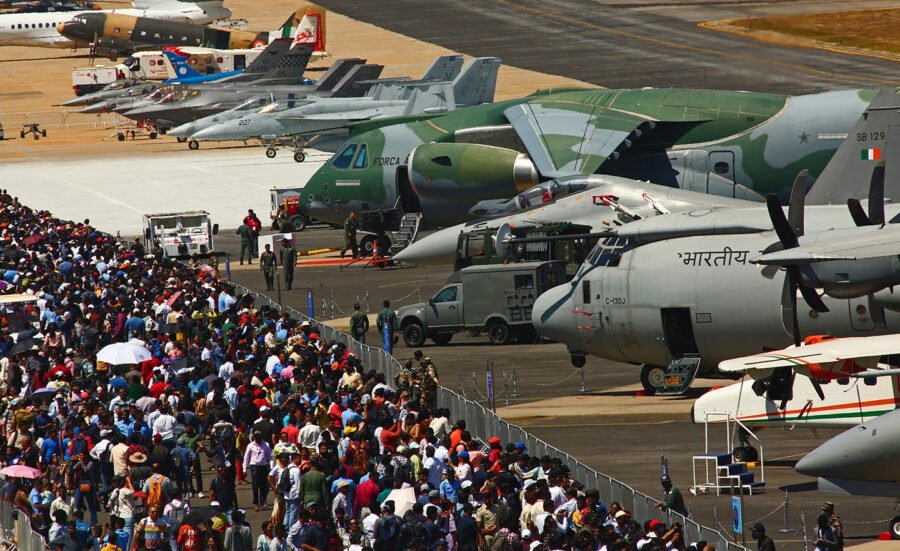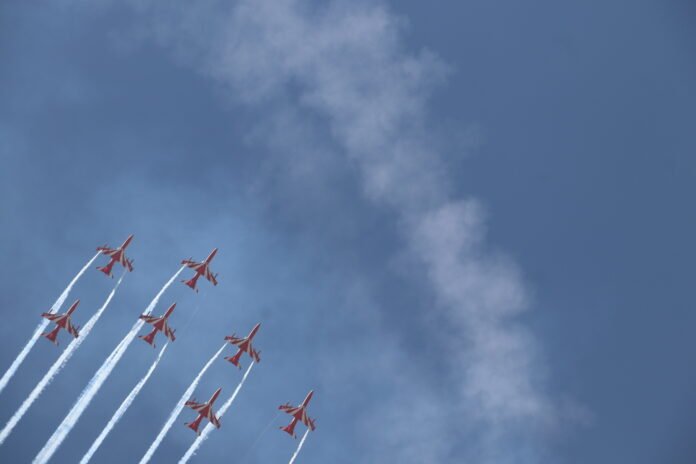The 15th edition of Asia’s biggest aero show aimed at forging new partnerships and explore avenues to fast-track indigenisation process, Aero India 2025 – will be held at the Air Force Station, Yelahanka in Bengaluru, Karnataka from February 10 to 14, 2025. With the broad theme ‘The Runway to a Billion Opportunities’, the event will provide a platform for forging partnerships between foreign and Indian firms and identifying newer avenues in the global value chain to accelerate the indigenisation process of Indian defence companies.
The highlights of the Aero India will be the Defence Ministers’ Conclave, CEOs’ Round-Table, Manthan start-up event, breath-taking air shows and a display of indigenous manufacturing capabilities.
To facilitate dialogue towards strategic partnership with friendly countries, India will host the Defence Ministers’ Conclave on the theme ‘BRIDGE – Building Resilience through International Defence and Global Engagement’. It encapsulates the dynamic geopolitical conditions and the path to mutual prosperity, which can be BRIDGED through cooperation among nations with shared vision of security and development.
A number of bilateral meetings are planned at the levels of the defence minister – before the air show, Chief of Defence Staff and the Defence Secretary among others on the sidelines of the event. The focus will be on bolstering the defence and aerospace ties with friendly countries by exploring newer avenues to take the partnership to the next level.
The CEOs’ Round-Table is expected to provide a favourable platform to foreign Original Equipment Manufacturers (OEMs) for manufacturing in India. Global CEOs, CMDs of domestic PSUs and premier private defence and aerospace manufacturing companies from India will participate at the event.
The India Pavilion will showcase India’s commitment to its Make in India initiative by showcasing indigenous defence manufacturing capabilities and cutting-edge technologies ready for the global stage, including the future prospects. Promotion of Indian start-ups is a focus area at Aero India 2025 and a wide spectrum of state-of-the-art technologies and products developed by them will be showcased at an exclusive iDEX pavilion.
Expectedly, India’s top-notch UCAV project – the Remotely Piloted Strike Aircraft (RPSA) will also be unveiled at Aero India. DRDO might reveal more details about this ambitious project at the biennial.
In addition, dynamic aerobatic displays and live technology demonstrations will provide an immersive experience, showcasing the potential of modern aerospace platforms and technologies. A number of seminars on various important themes are also planned as part of the event.
Aero India has already carved a niche for itself globally as a premier aerospace exhibition with 14 successful editions organised since 1996 in Bengaluru. The last edition achieved remarkable milestones as it attracted over seven lakh visitors, dignitaries from 98 countries and 809 exhibitors including businesses, investors, start-ups and MSMEs. Over 250 partnerships, including 201 MoUs, major announcements, product launches and technology transfers worth more than Rs 75,000 crore, were witnessed. The 2025 edition aims to surpass these achievements, and promises to be even bigger in scope and grandeur, besides clinching a raft of new agreements between Indian and foreign manufacturers.
To facilitate dialogue towards strategic partnership with friendly countries, India will host the Defence Ministers’ Conclave on the theme ‘BRIDGE – Building Resilience through International Defence and Global Engagement’. It encapsulates the dynamic geopolitical conditions and the path to mutual prosperity, which can be BRIDGED through cooperation among nations with shared vision of security and development
Indian Defence Ecosystem
The 15th edition of Aero India offers us an opportunity to reflect what India has gained by organising this show during the last 30 years.
Obviously, the show has contributed to increase India’s stature as a leading regional power, with a productive defence ecosystem, which has definitely grown tremendously during the last 15 years, due to unshackling of the defence manufacturers, both PSUs and the private sector, accompanied with a fresh perspective gaining ground in the corridors of the defence ministry. But the point to ponder here is whether India has been able to achieve its goals and have the policies establishing India as a leading defence producer and supplier?
If we look at the trajectory of Indian defence production and the exports over the last two decades, then a casual glance gives a rosy picture, but an in-depth analysis proves otherwise.

It seems that the country’s defence establishment has realised its shortcomings, too. At the 21st Subroto Mukerjee Seminar, themed “Aatmanirbharta in Aerospace: Way Ahead”, held in New Delhi on January 7, the Defence Secretary Rajesh Kumar Singh described India’s defence procurement system as “broken” and plagued by delays. According to R K Singh, India’s defence procurement policy, criticised for delays and inefficiencies, will be reformed within six months to a year. His remarks follow the Ministry of Defence’s (MoD’s) decision to observe 2025 as the “Year of Reforms” and its December announcement that the Defence Acquisition Procedure (DAP) 2020 is “likely to undergo a complete revamp” in 2025.
If such remarks come from the country’s top defence bureaucrat, then it definitely says that a lot needs to be changed, in order to fulfil our goals of making Indian Aatmanirbhar and also a preferred exporter for other countries.
The data shows that there has been a marked improvement in India’s domestic defence production in the past decade. In 2024, it was valued at Rs 1.27 lakh crore, a record high, and a 16.7 percent increase over the previous year. It was, in fact, the second year in a row that India’s defence production surpassed Rs 100,000 crore.
Private sector companies contributed 21 percent of the total or Rs 26,506 crore. As per defence ministry data, more than 14,000 MSMEs and close to 350 start-ups are engaged in defence production in India. The government has set an annual defence production target of Rs 300,000 crore by 2029, which would be an over three-fold jump from the current levels.
Aero India has already carved a niche for itself globally as a premier aerospace exhibition with 14 successful editions organised since 1996 in Bengaluru. The 2025 edition aims to surpass previous achievements, and promises to be even bigger in scope and grandeur, besides clinching a raft of new agreements between Indian and foreign manufacturers
To help defence production, the government liberalised the defence foreign direct investment (FDI) regime by enhancing the earlier foreign equity cap from a maximum of 26 per cent under the automatic route. Thus, the FDI liberalisation has led to an inflow of Rs 5,700 crore till 2024.
The Ministry of Defence (MoD), buoyed by the domestic industry’s growing capability, is increasingly awarding complex projects to the industry, both private and public. In 2023, the MoD signed contracts with the domestic industry for medium power radars and an integrated electronic warfare system (Bharat Electronics), HTT-40 basic trainer aircraft and Dornier-228 aircraft (Hindustan Aeronautics Limited), cadre training ships (L&T), improved Akash Weapon System (Bharat Dynamics Limited), Offshore Patrol Vessels and Missile Vessels (Goa Shipyard Limited and Garden Reach Shipbuilders and Engineers), Fleet Support Vessels (Hindustan Shipyard Limited) and upgraded super rapid gun mount (Bharat Heavy Electrical Limited).
What next?
However, as we are discussing this in the backdrop of Aero India, we must analyse how has the show helped India attain its futuristic goals in the arena of air power?
To move from being a “potent air power” to a “credible aerospace power”, the IAF plans to deepen its intelligence, surveillance and communication capabilities through the use of space technology. With help from DRDO, ISRO and others, it now plans to develop niche technologies like military satellites to meet India’s security objectives, including safeguarding its space-based assets.
To move from being a “potent air power” to a “credible aerospace power”, the IAF plans to deepen its intelligence, surveillance and communication capabilities through the use of space technology. With help from DRDO, ISRO and others, it now plans to develop niche technologies like military satellites to meet India’s security objectives, including safeguarding its space-based assets
But what India needs urgently is to develop strategies that would help it overcome the numerical and technological gap – in effectiveness and cost. While developing fifth and sixth-generation aircraft remains an essential way forward, an Anti-Access/Area Denial (A2/AD) strategy offers a pragmatic countermeasure, and could prevent adversaries from controlling airspace. China’s 5th generation and 6th generation stealth aircrafts, pose a significant challenge for India.
With the increased adoption of latest technologies, cyber capabilities are also becoming increasingly important in modern warfare. Developing a robust cyber defence mechanism and offensive capabilities will help India to protect against cyber threats and build resilience.
In fact, learning from the positive results delivered by the private sector, doors should be opened more for a much larger participation of the private sector in country’s defence manufacturing. In addition, it would be a real gamechanger if India could embark on a collaborative programme involving like-minded and friendly nations with major Indian defence manufacturers to fulfil its requirements. A case in the point is the submarine manufacturing, LCA Mk 2 fighter, AMCA, TEBDF or even the ambitious leap towards the 6th Gen fighters.
To overcome this, nurturing a strong domestic defence industry is required, which hinges on a well-developed ecosystem of suppliers, manufacturers, and skilled workers. Encouraging private sector participation, fostering innovation among startups (like iDEX), and building a skilled workforce are crucial steps in this regard.
What India needs urgently is to develop strategies that would help it overcome the numerical and technological gap – in effectiveness and cost. China’s 5th generation and 6th generation stealth aircrafts, pose a significant challenge for India
Also, we need to focus on how to fill-up the squadron shortfall in the IAF, what route should we take to enhance the numerical capability of the IAF. Should we still continue to wait for the LCA and its future versions or try to involve multiple players for early delivery of the LCA aircraft or instead buy an aircraft which the IAF has overlooked so far, such as Boeing F/A-18E/F Super Hornet, Boeing F-15EX Eagle II, Lockheed Martin F-21, a variant of the F-16V with customisations for India, Eurofighter Typhoon, a fighter jet that Germany is pushing for India’s MRFA tender and Saab JAS-39 Gripen E/F?
India and IAF have missed the opportunity to procure more Dassault Rafale. With 220 aircraft as backlog, Dassault Aviation delivery pipeline is choked and will take almost a decade to meet IAF’s requirement. Moreover, IAF seems least interested in Russian Mikoyan MiG-35 and Sukhoi Su-35.

According to media reports, Aero India 2025 will see US’ 5th generation fighter jet F-35 and Russia’s Su-57 battling up to garner IAF’s attention. Saab has already announced that it will be showcasing the full scale replica of Gripen E during the airshow.
In addition, the IAF also needs to redefine its aerial strategy, we should try to focus on developing an array of UCAVs as wingmen of the fighter aircrafts, and these UCAVs should indulge in tactical aerial and land warfare.
We need to focus on how to fill-up the squadron shortfall in the IAF, what route should we take to enhance the numerical capability of the IAF. Should we still continue to wait for the LCA or try to involve multiple players for early delivery of the LCA aircrafts or instead buy an aircraft which the IAF has overlooked so far?
To realise such concepts, a lot of support will have to be provided to the Indian drone industry, which in a short span of time has been able to deliver considerable results.
In sum, we’ll have to adopt a strategy which ensures early deliveries at lower costs and also manufacture products which are in demand globally and regionally. The MoD should provide support to the private sector entities which are ready to collaborate with global players to increase their capacities, but can’t due to several government controls.
The aerospace industry offers a lot of opportunities to the Indian entrepreneurs provided they are set free from government shackles, only then sky will be the limit to their successful endeavours.
-The writer is a New Delhi-based senior commentator on international and strategic affairs, environmental issues, an interfaith practitioner, and a media consultant. The views expressed are personal and do not necessarily carry the views of Raksha Anirveda

















